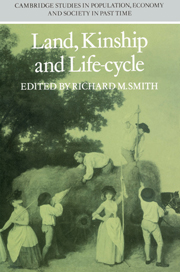Book contents
- Frontmatter
- Contents
- List of contributors
- Preface
- 1 Some issues concerning families and their property in rural England 1250–1800
- 2 Population pressure, inheritance and the land market in a fourteenth-century peasant community
- 3 Families and their land in an area of partible inheritance: Redgrave, Suffolk 1260–1320
- 4 Population changes and the transfer of customary land on a Cambridgeshire manor in the fourteenth century
- 5 Industrial employment and the rural land market 1380– 1520
- 6 Changes in the size of peasant holdings in some west midland villages 1400–1540
- 7 The erosion of the family–land bond in the late fourteenth and fifteenth centuries: a methodological note
- 8 Changes in the link between families and land in the west midlands in the fourteenth and fifteenth centuries
- 9 Kinship in an English village: Terling, Essex 1550–1700
- 10 The myth of the peasantry: family and economy in a northern parish
- 11 Poverty, poor relief and the life-cycle: some evidence from seventeenth-century Norfolk
- 12 The receipt of poor relief and family situation: Aldenham, Hertfordshire 1630–90
- 13 Widows in pre-industrial society: an essay upon their economic functions
- 14 Real property, marriage and children: the evidence from four pre-industrial communities
- 15 The nineteenth-century peasantry of Melbourn, Cambridgeshire
- Consolidated Bibliography
- Index
4 - Population changes and the transfer of customary land on a Cambridgeshire manor in the fourteenth century
Published online by Cambridge University Press: 19 October 2009
- Frontmatter
- Contents
- List of contributors
- Preface
- 1 Some issues concerning families and their property in rural England 1250–1800
- 2 Population pressure, inheritance and the land market in a fourteenth-century peasant community
- 3 Families and their land in an area of partible inheritance: Redgrave, Suffolk 1260–1320
- 4 Population changes and the transfer of customary land on a Cambridgeshire manor in the fourteenth century
- 5 Industrial employment and the rural land market 1380– 1520
- 6 Changes in the size of peasant holdings in some west midland villages 1400–1540
- 7 The erosion of the family–land bond in the late fourteenth and fifteenth centuries: a methodological note
- 8 Changes in the link between families and land in the west midlands in the fourteenth and fifteenth centuries
- 9 Kinship in an English village: Terling, Essex 1550–1700
- 10 The myth of the peasantry: family and economy in a northern parish
- 11 Poverty, poor relief and the life-cycle: some evidence from seventeenth-century Norfolk
- 12 The receipt of poor relief and family situation: Aldenham, Hertfordshire 1630–90
- 13 Widows in pre-industrial society: an essay upon their economic functions
- 14 Real property, marriage and children: the evidence from four pre-industrial communities
- 15 The nineteenth-century peasantry of Melbourn, Cambridgeshire
- Consolidated Bibliography
- Index
Summary
In their pessimistic accounts of the economic conditions of the English peasantry in the late thirteenth and early fourteenth centuries Professor Postan and Dr Titow not only used evidence on entry fines, rents, shrinking holding sizes, limited livestock resources and the coincidence of harvest failures and surges of tenant deaths, but also gave considerable attention to the position of the widow in the network of village land exchanges. They showed that marriage to widows who had succeeded to their husband's land was a prominent means of access to property by males, on manors without sizeable reserves of colonizable land. Dr Titow's analysis of these matters was static over space rather than dynamic over time. In this discussion we wish, with the aid of a detailed manorial case study, to consider the position of widows in the context of the inheritance and land transaction practices exhibited by the customary tenants on the Abbot of Crowland's Cambridgeshire manor of Cottenham. Our focus will be on the first eight decades of the fourteenth century, when demographic changes substantially shifted the ratio of labour to land in favour of the customary tenants.
Cottenham was one of the three Cambridgeshire manors of the Abbot of Crowland for which Miss Page estimated the intensity of mortality from plague in 1349. Her calculations showed 33 out of 58 tenants (57 per cent) dying in the plague.
- Type
- Chapter
- Information
- Land, Kinship and Life-Cycle , pp. 197 - 226Publisher: Cambridge University PressPrint publication year: 1985
- 1
- Cited by

